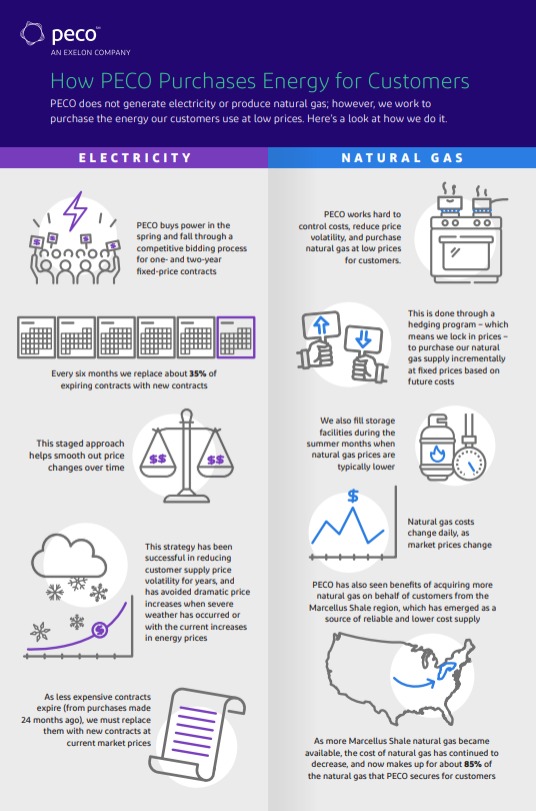While prices for everyday items seem to be higher than ever before, energy prices have begun to decline in recent months, reducing customer bills. It is anticipated that natural gas prices will continue to stabilize due to increased domestic production and lower overall domestic demand. Natural gas prices also impact the price of electricity because it’s a primary fuel source for electricity generation in our region.
Safely delivering the energy our customers need is critical, but at PECO, managing the cost to customers is also important. Here’s what we’re doing to manage the price of the natural gas and electricity we purchase on behalf of our customers.
First, it’s important to know that a customer’s bill is made up of two main parts – a delivery charge and a supply charge. Learn more about your bill through the following video.
- The delivery charge, or the portion of the bill that covers PECO’s costs to deliver natural gas or electricity, is about half of a residential customer’s bill.
- The supply charge is the portion of the bill that accounts for the actual natural gas or electricity that is used by a customer. Supply can be purchased through a competitive energy supplier or from PECO. When purchased from PECO, these costs are passed along to customers at exactly the cost that PECO pays, without a profit mark-up. These prices change quarterly and more information about current and future rates can be accessed through the electricity and natural gas Price to Compare pages.
Let’s first look at natural gas:
Natural gas costs fluctuate based on many factors. PECO works hard to control costs, reduce price volatility, and purchase natural gas at the lowest price possible for customers. This is done, in part, through a hedging program (locking in prices) to purchase our natural gas supply incrementally at fixed prices based on future costs and also by filling storage facilities during the summer months when natural gas prices are typically lower. These costs change daily, as market prices change.
In addition, PECO has seen the benefits of acquiring more natural gas on behalf of customers from the Marcellus Shale region, which has emerged as a source of reliable and lower cost supply. Prior to the availability of Marcellus Shale natural gas in western Pennsylvania, PECO would secure natural gas from the Gulf of Mexico region, which was more expensive and more prone to supply issues caused by storms. As more Marcellus Shale natural gas became available, the cost of the natural gas continued to decrease, and PECO continued to secure more lower priced supply from the region. Marcellus Shale natural gas now makes up about 85 percent of the natural gas that PECO secures for customers.
Now, from an electricity perspective:
PECO does not generate electricity, rather we purchase the lowest cost electric supply for customers by buying power in the spring and fall through competitive bidding processes for one- and two-year fixed-price contracts. Every six months we replace about 35 percent of expiring contracts with new contracts. This staged approach helps smooth out price changes over time. This is a strategy that has been successful in reducing customer supply price volatility for years and has avoided dramatic price increases when severe weather has occurred or with the recent increases in energy prices.
However, as less expensive contracts expire from purchases made 12 to 24 months ago, we must replace them with new contracts at current market prices.
While we work to keep energy supply prices as low as possible, there are things every customer can do in this environment to gain control over their energy use and costs to save money. This includes:
- Using energy as efficiently as possible and monitoring usage,
- Signing up for energy efficiency programs, and
- Taking advantage of financial assistance and bill relief programs.

